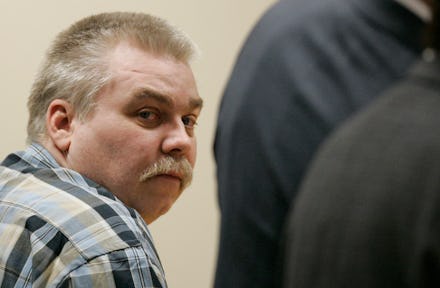Here's Evidence in the Steven Avery Case That Was Left Out of 'Making a Murderer'

Since Making a Murderer came out in December, mention of the name Steven Avery have largely provoked outrage from the show's viewers, many of whom believe the Wisconsin man to be innocent in the 2005 murder of local photographer, Teresa Halbach. In their docudrama — which took 10 years to create — filmmakers Moira Demos and Laura Ricciardi catalog what ends up looking like a gross miscarriage of justice on Wisconsin's part. Demos and Ricciardi have been clear, though, that they cannot say whether or not their subject is guilty.
"What I learned from making this series is the humility to accept that I don't know, and I may never know," Demos told the Daily Beast. "Just because you have questions doesn't mean that you're going to get an answer. If you're so committed to finding the truth and finding the answer, it's very hard to be comfortable with ambiguity and you'll often settle, just for some finality," she continued.
Ricciardi and Demos trace Avery's story all the way back to his first long-term prison sentence in 1985, when he was wrongfully convicted of sexual assault. Avery served 18 years before DNA evidence exonerated him in 2003; as the series seems to suggest, the state's subsequent prosecution of Avery — and of his nephew, Brendan Dassey — was the result of local law enforcement's long-held grudge against Avery. Yet the special prosecutor on the case, then Calumet County's District Attorney Ken Kratz, insists that the filmmakers left evidence out of Making a Murderer, and in so doing, presented a lopsided view of the case. Kratz maintains that the curation of evidence falsely depicts Avery as innocent.
Here's a look at some of what we apparently didn't see in the documentary.
More DNA found in the car
According to Kratz, one of the important pieces of evidence the series doesn't mention is what the sweat investigators found under the hood of Halbach's Toyota Rav4 — sweat that Kratz told Maxim came from Avery's palms. Viewers will recall that Avery's blood was also found smeared in small patches around the car's interior; defense lawyer Dean Strang eventually made a case for that blood having been planted by law enforcement. The documentary states that Avery's fingerprints weren't found anywhere in the vehicle, and that the only cut on Avery's body was on his finger: In order to keep the car free of prints, Avery would have needed to wear gloves. Defenders argued in the trial that he would not have left behind traces of blood had he been wearing gloves.
Suspicious items found around the Avery compound
What's trickier to get around is Kratz's allegation that Halbach's cell phone and camera "were found 20 feet from Avery's door, burned in his barrel," where some of the victim's remains were also found. Kratz told Maxim that two witnesses saw the defendant place these objects in the barrel. "This isn't contested," he said.
A 2006 article in Milwaukee Magazine, "Blood Simple," reported that "a pair of handcuffs and leg irons" were found in Avery's house, which the defendant claimed he'd purchased so that he and his then-girlfriend, Jodi, could experiment. According to OnMilwaukee, the same items were found in Dassey's home; neither Halbach's nor Dassey's DNA were found on any of these articles, which seems unlikely if in fact they were used to restrain the victim as the two men assaulted her.
OnMilwaukee also reported that Halbach's charred bones were mixed up with bits of steel belt fragments, which could have been used as fire accelerants. The Averys run an auto salvage yard, so this could either be incriminating or expected, considering that her bones were found in two spots on the property.
The not-so-smoking gun
Then, there's the flattened bullet with Halbach's DNA on it, which investigators found in Avery's garage in March 2006. According to People, Kratz says the bullet — which came from the gun that hung in Avery's bedroom — had been confiscated by police in Nov. 2005, in the course of their search of the Avery property. Kratz is probably correct in his assertion that "the bullet had to be fired before Nov. 5," but that doesn't necessarily negate the possibility that the police planted it, as Avery's defense attorneys suggest in the documentary. There's the vial of Avery's blood to consider again: Seals on its packaging had been broken, and a tiny hole had been made in the cap, as if someone had plunged a needle through it. The blood was in the custody of the county clerk's office.
Whatever evidence Demos and Ricciardi may have kept out of their documentary, many viewers said they thought defenders had enough to demonstrate that both Avery and Dassey were unfairly tried, and that law enforcement did — on a number of occasions — go against procedure in the course of their investigation. Regardless of Avery's innocence, the documentary's takeaway remains the same: The criminal justice system doesn't always work within the confines of the law, nor does it necessarily take civilians' welfare to heart.